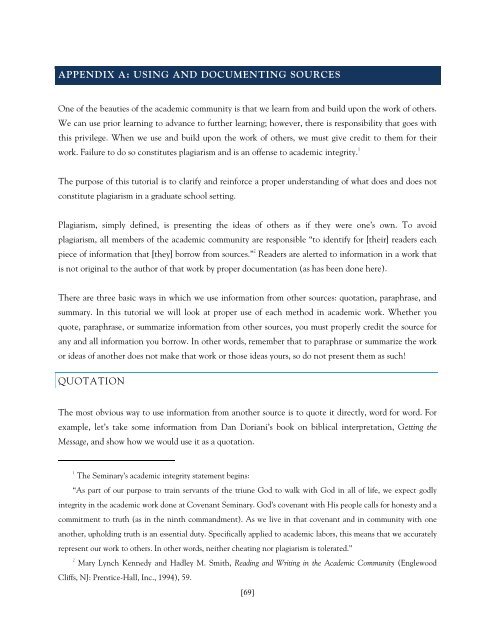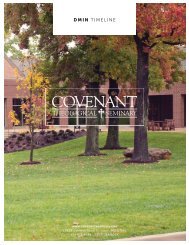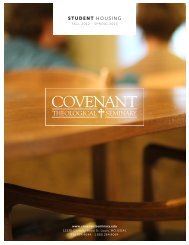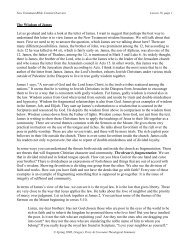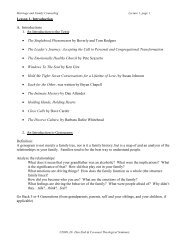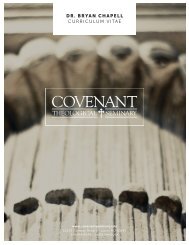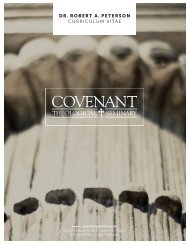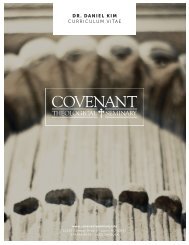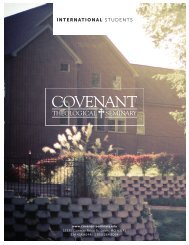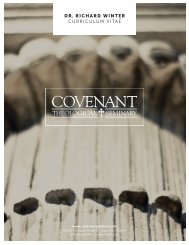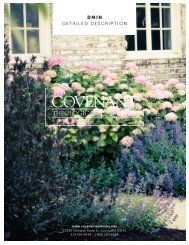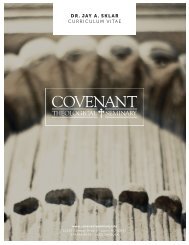APPENDIX A: USING AND DOCUMENTING SOURCESOne of <strong>the</strong> beauties of <strong>the</strong> academic community is that we learn from and build upon <strong>the</strong> work of o<strong>the</strong>rs.We can use prior learning to advance to fur<strong>the</strong>r learning; however, <strong>the</strong>re is responsibility that goes withthis privilege. When we use and build upon <strong>the</strong> work of o<strong>the</strong>rs, we must give credit to <strong>the</strong>m for <strong>the</strong>irwork. Failure to do so constitutes plagiarism and is an offense to academic integrity. 1The purpose of this tutorial is to clarify and reinforce a proper understanding of what does and does notconstitute plagiarism in a graduate school setting.Plagiarism, simply defined, is presenting <strong>the</strong> ideas of o<strong>the</strong>rs as if <strong>the</strong>y were one’s own. To avoidplagiarism, all members of <strong>the</strong> academic community are responsible “to identify for [<strong>the</strong>ir] readers eachpiece of information that [<strong>the</strong>y] borrow from sources.” 2 Readers are alerted to information in a work thatis not original to <strong>the</strong> author of that work by proper documentation (as has been done here).There are three basic ways in which we use information from o<strong>the</strong>r sources: quotation, paraphrase, andsummary. In this tutorial we will look at proper use of each method in academic work. Whe<strong>the</strong>r youquote, paraphrase, or summarize information from o<strong>the</strong>r sources, you must properly credit <strong>the</strong> source forany and all information you borrow. In o<strong>the</strong>r words, remember that to paraphrase or summarize <strong>the</strong> workor ideas of ano<strong>the</strong>r does not make that work or those ideas yours, so do not present <strong>the</strong>m as such!QUOTATIONThe most obvious way to use information from ano<strong>the</strong>r source is to quote it directly, word for word. Forexample, let’s take some information from Dan Doriani’s book on biblical interpretation, Getting <strong>the</strong>Message, and show how we would use it as a quotation.1The <strong>Seminary</strong>’s academic integrity statement begins:“As part of our purpose to train servants of <strong>the</strong> triune God to walk with God in all of life, we expect godlyintegrity in <strong>the</strong> academic work done at <strong>Covenant</strong> <strong>Seminary</strong>. God’s covenant with His people calls for honesty and acommitment to truth (as in <strong>the</strong> ninth commandment). As we live in that covenant and in community with oneano<strong>the</strong>r, upholding truth is an essential duty. Specifically applied to academic labors, this means that we accuratelyrepresent our work to o<strong>the</strong>rs. In o<strong>the</strong>r words, nei<strong>the</strong>r cheating nor plagiarism is tolerated.”2Mary Lynch Kennedy and Hadley M. Smith, Reading and Writing in <strong>the</strong> Academic Community (EnglewoodCliffs, NJ: Prentice-Hall, Inc., 1994), 59.[69]
Doriani writes in his book, “The fundamental skill for biblical interpretation, as in much of life, isobservation. All o<strong>the</strong>r skills depend on it.” 3 We might use this quote in a paper on biblical interpretationlike this:It takes work and practice to interpret <strong>the</strong> Bible properly. To do it right, we must develop certain skills. Themost important skill, according to one scholar who has written on <strong>the</strong> subject, is observation. Dan Dorianiwrites, “The fundamental skill for biblical interpretation, as in much of life, is observation. All o<strong>the</strong>r skillsdepend on it” (Doriani, 14). It is imperative, <strong>the</strong>refore, that we start developing our skills of observation.The above example illustrates proper use of ano<strong>the</strong>r source by straightforward quotation. Theinformation from <strong>the</strong> original source is copied exactly (word for word), is enclosed in quotation marks,and <strong>the</strong>n is documented with paren<strong>the</strong>tical notes, footnotes, or endnotes. Note: When you use quotationmarks, you are saying that <strong>the</strong> words enclosed in quotes are <strong>the</strong> exact words of <strong>the</strong> author. If <strong>the</strong>y are not<strong>the</strong> exact words of <strong>the</strong> author, you are misusing <strong>the</strong> marks.Sometimes it is necessary to modify <strong>the</strong> wording of <strong>the</strong> source to fit <strong>the</strong> context in which one is using it.It is legitimate to do so, provided that proper methods are used to signal <strong>the</strong> modification and that <strong>the</strong>whole is still attributed to its source.For example, we may want or need to shorten a quotation slightly to fit our space and use. An ellipsis(three spaced dots) is used to indicate where material in <strong>the</strong> original source was left out. (Note: You maynot leave out words in a way that changes <strong>the</strong> meaning of <strong>the</strong> original.) Continuing with Doriani’s wordsabove, we might shorten it to say:The most important skill, according to one scholar who has written on <strong>the</strong> subject, is observation. Dan Dorianiwrites, “The fundamental skill for biblical interpretation . . . is observation. All o<strong>the</strong>r skills depend on it”(Doriani, 14). It is imperative, <strong>the</strong>refore, that we start developing our skills of observation.Sometimes we need to modify <strong>the</strong> wording of a quotation to fit <strong>the</strong> context in which we are using it. Wemay have to adjust verb tenses or pronoun cases, or explain unclear referents. Such changes arelegitimate as long as <strong>the</strong>y are indicated to <strong>the</strong> reader by placing <strong>the</strong> altered or added words in bracketsand as long as <strong>the</strong>y do not change <strong>the</strong> text’s meaning. To illustrate this using Doriani’s words, we mightcompose a paragraph like <strong>the</strong> following:3Dan Doriani, Getting <strong>the</strong> Message (Phillipsburg, NJ: Presbyterian and Reformed Publishing, 1996), 14.[70]
- Page 5 and 6:
TRANSCRIPTS .......................
- Page 7 and 8:
MASTER OF THEOLOGY, EXEGETICAL THEO
- Page 9:
forth the Seminary’s understandin
- Page 12 and 13:
“Distance Education” section of
- Page 14 and 15:
Practicum (or a similar course) and
- Page 16 and 17:
‣ Field Education Requirement: Su
- Page 18 and 19:
maximum of 30 hours of transfer cre
- Page 20 and 21:
guides for the exam are available o
- Page 22 and 23:
Exegetical Theology: exegesis, bibl
- Page 24 and 25:
study.‣ Distance Education Studie
- Page 26 and 27: the time of their application for a
- Page 28 and 29: Stop.TIME LIMITATIONSDistance educa
- Page 30 and 31: een applied, plus a $30 deferred pa
- Page 32 and 33: application submitted through the R
- Page 34 and 35: outinely granted will apply to stud
- Page 36 and 37: einstatement prior to registration
- Page 38 and 39: ACADEMIC LIFEATTENDANCEStudents are
- Page 40 and 41: ThM students are full-time when reg
- Page 42 and 43: Handbook.)LANGUAGE AUDIT POLICYGene
- Page 44 and 45: the following grade system:A 4.0 Ou
- Page 46 and 47: Academic probation is a warning tha
- Page 48 and 49: Covenant Seminary welcomes students
- Page 50 and 51: that scholarship will continue.RE-A
- Page 52 and 53: ecord to fulfill their professional
- Page 54 and 55: may be given for appropriate parall
- Page 56 and 57: 8. Field education (for MDiv, MAEM,
- Page 58 and 59: CAMPUS LIFECOMMUNITY GROWTH IN GRAC
- Page 60 and 61: Bulletin Board posting campus month
- Page 62 and 63: service should contact the counseli
- Page 64 and 65: • For all other Covenant material
- Page 66 and 67: The lunchroom in Edwards Hall is op
- Page 68 and 69: student experiences. Both committee
- Page 70: epresentatives are expected to keep
- Page 73 and 74: words, attitudes and thoughts (e.g.
- Page 75: 2. Arrange to minimize job-related
- Page 79 and 80: those of the original source, just
- Page 81 and 82: [74]
- Page 83 and 84: 11. The names of associations, agen
- Page 85 and 86: l. Policies concerning the possessi
- Page 87 and 88: e. Procedures to inspect student’
- Page 89 and 90: THIRD YEAR Fall Jan-term SpringCM34
- Page 91 and 92: FOURTH YEAR Fall Jan-term SpringOT3
- Page 93 and 94: FOURTH YEAR Fall Jan-term SpringCH3
- Page 95 and 96: MASTER OF ARTS, EXEGETICAL THEOLOGY
- Page 97 and 98: MASTER OF ARTS IN EDUCATIONAL MINIS
- Page 99 and 100: MASTER OF ARTS IN RELIGION AND CULT
- Page 101 and 102: NT core courses include any course
- Page 103 and 104: CORE UNITS: 45Biblical/Theological
- Page 105 and 106: MASTER OF ARTS, THEOLOGICAL STUDIES
- Page 107 and 108: MASTER OF THEOLOGY, EXEGETICAL THEO
- Page 109 and 110: WHOM TO CONTACTTo find out about:..
- Page 111 and 112: To find out about..................


